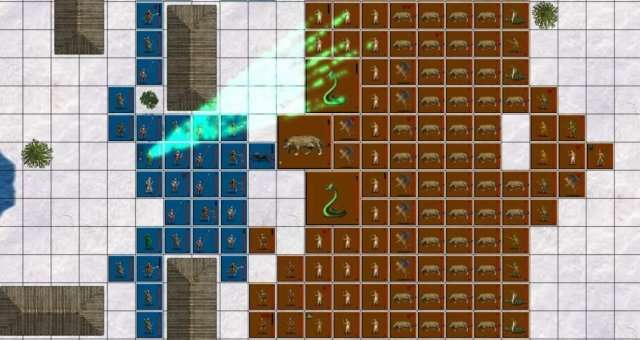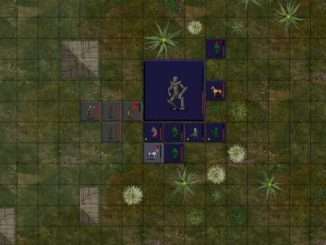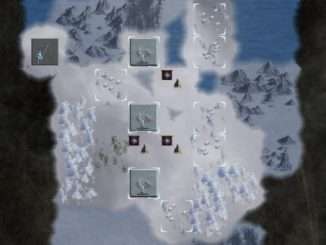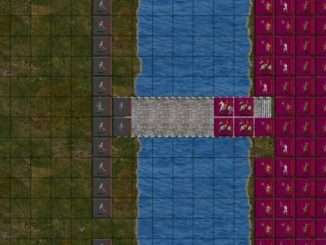
This guide discusses weapons, damage and death in the game in more detail.
Weapons Damage and Death Overview
Weapons
The weapons of a unit are listed after the primary statistics. Some units may have the same weapon more than once, indicating that they are skilled enough to make multiple attacks in one round with the same weapon. High Lords and Gladiators are examples of such units. For the purposes of combat and damage mechanics, spells function exactly like weapons and spellcasting is only limited by the restrictions of a particular Cast Spell type weapon.
Weapon Types
There are several weapon types. Usually weapons with range 1 are melee weapons that can only be used in melee and those with longer range are missile weapons that cannot be used in melee. Spells only have a small chance of being used if the caster is engaged in melee combat. If a spell is cast no other type of attacks will be done that round. However sometimes the attack name is followed by a special marker (e.g. two stars **) that indicates that it can be used in other circumstances than usual.
Melee Weapon#
Either this attack or the following attack will be used, but both cannot be used on the same combat round.
Ranged Weapon*
This ranged weapon may be used in melee instead of other attacks.
Ranged Weapon**
This ranged weapon can also be used in melee and in addition to other attacks.
Ranged Weapon#
Either this attack or the following attack will be used, but both cannot be used on the same combat round. This ranged weapon can be used in melee.
Cast Spell**
This spell attack may be used in melee and in addition to other attacks.
Cast Spell#
Either this attack or the following attack will be used, but both cannot be used on the same combat round. This spell attack can be used in melee.
Special: Siege
Siege weapons are only used when attacking or defending fortified structures like walled cities or guard towers.
Special: Burst
Usually a weapon only hits one unit, but a large burst area means it will cover multiple squares. Weapons with burst damage will damage structures and vegetation in the square as anyone standing there.
Special: Assassination
Assassination attacks will be used once before the battle starts. For assassination attacks to be used the assassin must be on the attacking side.
Range
This is the weapon’s range in squares. Melee weapons have a default range of 1 and a bow has a default range of 5. Really long melee weapons like pikes have a range of 2 and can strike units up to 2 squares away, even though it is a melee weapon.
Damage Types
Weapons can do several different types of damage. Each type may be normal or magical (e.g. magical or non-magical blunt damage).
- Blunt (icon: hammer). Normal damage that is caused by e.g. hammers and maces.
- Piercing (icon: spear). Normal damage that is caused by e.g. arrows and spears.
- Slashing (icon: sword). Normal damage that is caused by e.g. swords and axes.
- Fire (icon: flame). Anyone wounded by fire damage also risks catching fire. Burning units will take damage each combat round until the fire stops.
- Cold (icon: icicles). Anyone wounded by cold damage also risks getting the Numbness affliction. Units with Numbness gets -1 Strength and takes +1 damage when wounded by any attack.
- Shock (icon: lightning bolt). Anyone wounded by shock damage also risks getting stunned. A successful magic resistance or Strength check is required to not be affected.
- Poison (icon: drop of green liquid). Poison damage will not result in any immediate damage, instead it is spread out over a number of turns.
- Acid (icon: drop of purple liquid). Acid damage is very difficult to resist as very few units are immune to this type of damage.
- Magic (icon: blue-white starburst). Pure magic damage is often caused by spells. Other types of damage can also combine with magic, meaning that they can affect ethereal creatures without any trouble.
Armor subtracts from damage received unless the attack causes armor negating (AN) damage.
In addition to these damage types there are also many attacks that cause special effects that do not cause actual damage (e.g. confusion, charm, paralyzation).
Area of Effect
All weapons have an area of effect. Most weapons affect a single target. This is denoted as “area of effect: single target” and affects a single enemy in the square where it strikes. If no enemy is in the square it will affect any ground object there instead.
There are a few different types of area of effects:
- Burst affects a number of squares equal to the burst value. The shape of the affected area may depend on the type of attack. Some spells or other attacks have a fan-shaped distribution, others a starburst and yet others a sphere, etc.
- Beam area of effect is always a number of consecutive squares and the weapon affects all squares in the path of the beam.
- Strike effects are usually a property of spells and each strike affects a single target. The distribution of the strikes on the battlefield can be entirely random within range of the weapon or spell and can strike targets in different parts of the field. The Necromancy spell Dark Power is an example of this type.
- Cone weapons affect a conical area in front of the attack’s origin point and affect all squares in that area. There are also wide and narrow cones, meaning they affect more or less of the surrounding squares.
All area effects that affect one or more squares will also affect any ground objects in the same square. E.g. an archer standing on a parapet is hit by a fireball. This will cause the parapet he is standing on to take damage from the fireball in addition to the archer himself.
Weapons and spells that affect multiple targets in beam or cone attacks can be just as dangerous to your own forces as to the enemy, sometimes even more so.
Additional Weapon Attributes
Weapons may have additional attributes that modify their behavior to differ from a standard weapon. The most common additional attributes are described below.
- Extra Effect if Hit If the weapon hits the target, the target suffers an additional effect, which may be different type of damage (e.g. poison from a venomous bite) or possibly special damage.
- Armor Negating weapons ignore all armor values, defense bonuses and shields of the target.
- Assassination weapons are used before the battle begins to make a free attack on the enemy. Assassination attacks may only be used by the attacking player. Assassination weapons are also modified by all other additional attributes.
- Drain In addition to causing damage to their targets, life draining attacks add an equal amount of Hit Points to the attacker, healing them of damage already suffered or augmenting their Hit Points beyond the normal maximum. The maximum amount of HP gain is twice the unit’s normal maximum HP. This limit is affected by reductions of maximum HP due to afflictions. The HP augmentation wears off with time.
- Long weapons may be used to strike enemies two squares away.
- Negates Shields, damage from this attack cannot be reduced by the Shield or Large Shield special ability.
- Siege weapons are only usable in battles that take place in a square that is considered to be a fortification, such as a city, guard tower, castle or similar structure. See Combat guide for more details on siege mechanics.
- Strikes anywhere, This weapon may strike anywhere on the battlefield.
- Strikes rear This weapon always strikes a target in the rearmost enemy row. Typically only a property of assassination weapons.
- Sweep If the attack kills its target, the leftover damage will immediately carry on to a new attack against another melee target. Great Swords and Great Clubs have this attribute.
- Full Sweep The attack will target all nearby targets, but with -1 damage after each target. Dragons sweeping with their tails have this attribute.
Death
When the Hit Points of a unit reach 0, it dies. Death is permanent, unless a unit is immortal. Dead units cannot be brought back to life by any means. The only exception is if a regenerating unit on the winning side of a battle is killed but suffered less than 150% of its HP in damage. In this instance the unit has a chance to return from the dead, but it is not guaranteed. Regenerating units on the losing side cannot return from the dead, since the winners make sure they are sufficiently dismembered to prevent any revival.
Immortality
Immortal units reform at their home after they are killed. If their home is lost, even immortal units die permanently when slain. Note that the home location is not automatically the player’s home citadel. For example, the home of a Vampire is the old castle ruin where the blood rite ritual to turn a necromancer to a vampire was performed.
A special form of immortality is Other Planar Immortality. Gods and powerful Demon Lords often have this ability which means that they must be slain on their home plane in order to die permanently. If slain on another plane, they will respawn on their home plane and usually shred any bindings that might have held them previously. E.g. a demon lord controlled by a demonologist is slain on Elysium. This will force it to respawn in its home in Inferno and it will be free from the Demonologist’s control in the process.
Damage Display
Damage taken by units in combat is displayed as floating numbers that rise up from the unit and fade away on the battlefield. Damage is normally displayed as floating red numbers. If the unit suffers from special damage as an ongoing effect such as decay or burning or receives damage from striking an enemy with a protective ability such as Fire or Cold Aura, the damage is displayed in a different color. The colors for strikeback and ongoing damage effects depend on what type of damage the unit has suffered. Healing effects are displayed with a plus sign.
- Red Blunt, piercing, slashing
- Yellow Fire
- Blue Cold, drowning
- Light Blue Shock
- Green Poison
- Pale Purple Acid
- White Magic
- Purple Decay
Damage Mechanics
Boolean Damage
Some damage effects are boolean in nature, meaning that they either affect the target, in which case the target suffers the full effects of the damage, or they do not affect the target at all. Boolean damage is often subject to a resistance check, usually against magic resistance, morale or strength and sometimes multiple attributes can be used to resist the effect. Many special damage effects, especially if caused by spells, are boolean in nature.
Open Ended Dice
Most weapons and damage dealing spells in the game inflict a variable amount of damage (for example, 1-5 points of piercing damage from a spear). Damage in Conquest of Elysium is inflicted on the basis of an open-ended die. This means that when damage is rolled, if maximum damage is rolled, another die of additional damage is rolled. An additional die is rolled every time the last one comes up with the highest possible value. Thus a lucky hit can cause massive damage far in excess of normal.
All additional dice have 1 point subtracted from the result of the roll.
Note: Weapons with a damage rating of 1 have a 50% chance of having the damage rating increased to 1d2 and becoming an open-ended die.
Tip: A pikeman hits a target and rolls damage: 1d5 (oe), with results 5, 5, 5, 4. The actual result is 5 + 4 + 4 + 3 = 16.
Semi-Open Ended Dice
Semi-open ended dice function like open-ended dice, but only the first result is counted in full. All of the additional dice rolls are first reduced by 1 and the sum of the additional dice rolls is halved before adding it to the result of the first die. All fractions are rounded down.
Tip: A semi-open ended die roll of 1d5, with results 5, 5, 5, 4 would have an actual result of 5 + (4+ 4+ 3) / 2 = 10.
Damage Bonus
If a unit has a damage bonus, the bonus is not added directly to the result of the open-ended die roll. Instead, the damage bonus increases the size of the open-ended die. The damage bonus is displayed as 1dX(+Y), but in actual fact the effect is a damage value of 1d(X+Y). The damage bonus is displayed this way for aesthetic reasons and because some weapons can be replaced by weapons from items, in which case the damage bonus is applied to the new weapon.
Tip: The Troll King has a damage bonus of 25, so his Club (1d3 damage) actually does 1d28 damage. A hoburg soldier has a damage bonus of -2 so his spear (1d5 damage) only does 1d3 points of damage.
Immobilized Targets
Immobilized units (stunned, paralyzed etc.) take 2 extra points of damage from every attack.
Damage Calculation
Damage from a successfully landed attack is applied through the following steps:
- Roll total damage, open-ended dice.
- If the damage type was elemental (fire, cold, shock) or poison and the target has a vulnerability to that type, double the damage total.
- Add 1 if the target was immobilized.
- If target is standing on a wall, add 0 to (3x fortification level) to its armor.
- If target has armor, subtract the armor value from the damage total unless the attack was armor negating.
- Subtract 0-1 if the target has a shield (0-2 if large shield), unless the attack was armor negating or negates shields.
- If the damage type is blunt, slashing or piercing damage and the target has the relevant resistance, apply the resistance reduction (50%) to the damage total.
- If target has resistance to the damage type, apply the appropriate percentage reduction to the damage total
- If the resulting damage value is greater than 0, subtract the result from target’s HP. All fractions are rounded down. Damage reduction may result in the target not taking any damage at all.
Poison Damage
Poison damage works differently from other types of damage. The amount of damage suffered is determined normally, but it is applied differently. When a unit is inflicted with a total amount of poison damage, it takes 10% of the total every round (rounded up to the nearest whole number) until all the poison damage has been suffered.
Already poisoned units can become more poisoned by repeated exposure to poison attacks. The new value is added to the existing total poisoning so far. Poison Immunity grants immunity to new poison damage, but does not negate prior poisoning.
Tip: A Witch hits an Elephant with the spell Venom and poisons the Elephant for 13 points of damage. Over the following combat rounds the Elephant suffers all 13 points of poison damage in increments of 2, 2, 1, 1, 1, 1, 1, 1, 1, 1 and 1 points at which point the total has reached zero.
Special Damage
Some types of attacks do special damage, whose effects are not immediate or which will have an impact on a unit’s performance. Special damage that causes an effect will produce an icon in the unit’s row of special abilities.
Charm & Enslave
Both Charmed and Enslaved units immediately switch sides and attack their former comrades.
Charmed units retain their previous status, which means a charmed commander will still be a commander in the service of his new master. After the battle, charmed commanders will be placed under the command of the commander who charmed them and will be inactive until activated from the Transfer Units screen. See chapter Transfer Units for more information.
Enslaved units lose their commander status and become regular units. Enslaved mage commanders do NOT lose their spellcasting abilities, but can no longer learn new spells or use rituals. Enslaved units are automatically assigned to the commander who enslaved them. There is no icon for being charmed / enslaved.
Fear
Fear damage is applied against morale. If the damage roll from fear exceeds the morale of the target, the target panics and runs away. Fear attacks may sometimes be resisted with magic resistance, in which case the fear attack is negated and fear damage is not applied. Sleeping units are not affected by fear. They will have nightmares instead, but this does not have any effect. It is simply an indication that the condition of being asleep protected them.
Debuffs
Debuff effects weaken the target’s combat effectiveness, make it more vulnerable to damage, cause damage over time or cause permanent disabilities.
Curse
Cursed units have a greatly increased chance of receiving battle afflictions when they are hit. (icon: black demon head inside a red pentagram)
Decay
Decay Units suffering from decay take 1 point of damage per combat round until they die. Decay can usually not be survived, but after the battle has ended the effect will run out eventually and some extraordinarily tough creature might be able to survive it. (icon: hourglass)
Disease
Diseased units have their Strength lowered by one point immediately, but take no extra damage in combat. After combat, they have a 50% chance of taking 1 point of damage every month until they die. Disease is considered a battle affliction for purposes of healing (icon: pockmarked face).
Weakness
Weakened units have their Strength and damage reduced by 2 (icon: purple pentagram).
Confusion
Confused units do nothing (50% chance) or switch sides (10% chance) or move in a random direction instead of advancing (75%) (icon: pale green pentagram).
Immobilization
Immobilization effects render units immobile, preventing them from taking any actions other than trying to free themselves. Immobilized units take one extra point of damage from all attacks.
Earth Grip
Earth gripped units are immobilized until they pass a strength check vs 2d6. Passing a strength check vs 1d5+7 will have the unit break free and attack in the same round. (icon: brown pentagram)
Entanglement
Entangled units are immobilized until they pass a strength check vs 1d8. Passing a strength check vs 1d5+5 will have the unit break free and attack in the same round. (icon: green pentagram)
Imprisoned in Ice
Units imprisoned in ice are immobilized and gain 2 points of Armor, but take 1 point of cold damage every combat round until the effect wears off (20% chance each round). (icon: pale blue pentagram dripping icicles)
Paralyzation
Paralyzed units are immobilized and cannot do anything until the effect wears off. (10% chance each combat round). (icon: light gray pentagram)
Sleep
Sleeping units are immobilized. The unit sleeps until it is hit or awakens on its own. (5% chance each combat round) (icon: blue pentagram)
Stun
Stunned units are immobilized and cannot do anything until they recover. Stunned units have a 75% chance of recovering every round. (icon: dark gray pentagram)
Slime
Slimed units are not really immobilized and will not take extra damage from attacks, but they have a 50% chance of being unable to act every round. Slimed units have a 10% chance of getting rid of this effect every round. (icon: green slime)
Healing
Healing
Wounded units heal damage at the rate of 10% of their maximum HP per month (rounded up), unless they have a healing special ability such as Fast Heal or Regeneration that allows them to heal faster.
Many non living units have the Never Heals trait and any damage done to them is permanent. The only way for them to heal is usually by giving them a magic item that grants them false life.
Resurrection
Regenerating units on the side that won the battle have a chance of rising from the dead unless they suffered at least 150% of their HP worth of damage when they were killed. Regenerating units on the losing side cannot return from the dead, since the winners make sure they are sufficiently dismembered to prevent any revival.
Resistance Mechanics
This section explains how resistance rolls work. Effects that can be resisted with more than one attribute check against both attributes, and the target is only affected if both checks fail.
Magic Resistance
Magic resistance checks come in three varieties: Easy, normal and hard. They are often referred to respectively as easymr, mr and hardmr when discussing different kinds of checks. All MR checks are rolled against the target’s magic resistance. If the roll is equal to or greater than the magic resistance, the target fails to resist and the effect is applied. MR checks use semi-open ended dice rolls.
- EasyMR 1d5 < MR = resisted
- MR 2d4 < MR = resisted
- HardMR 2d6 < MR = resisted
Strength Resistance
Effects that are resisted with strength (such as the stun effect from the Gust of Wind spell) work exactly like magic resistance checks, but the determining attribute is strength instead of MR.





Be the first to comment